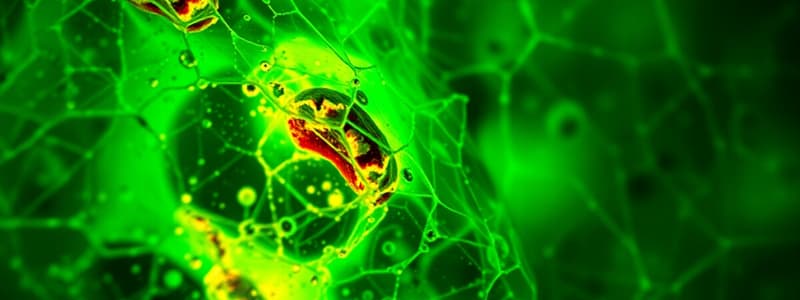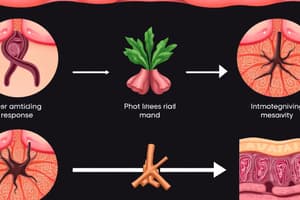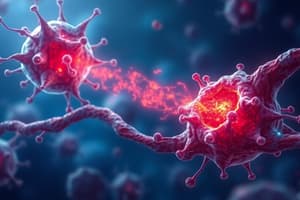Podcast
Questions and Answers
The initial response to injury is chronic inflammation.
The initial response to injury is chronic inflammation.
False (B)
Regeneration involves the replacement of lost tissue by tissue of the same type.
Regeneration involves the replacement of lost tissue by tissue of the same type.
True (A)
Repair typically results in the restoration of the original tissue architecture.
Repair typically results in the restoration of the original tissue architecture.
False (B)
Labile cells are continuously dividing cells found in tissues like the epidermis and GI tract epithelium.
Labile cells are continuously dividing cells found in tissues like the epidermis and GI tract epithelium.
The ability of tissues to regenerate does not depend on the presence of stem cells.
The ability of tissues to regenerate does not depend on the presence of stem cells.
Wound healing by secondary intention is faster than healing by primary intention.
Wound healing by secondary intention is faster than healing by primary intention.
Excessive scar formation can result in keloids.
Excessive scar formation can result in keloids.
In the central nervous system, healing involves regeneration of nerve tissue.
In the central nervous system, healing involves regeneration of nerve tissue.
Local factors affecting wound healing include poor vascular supply and infection.
Local factors affecting wound healing include poor vascular supply and infection.
A lack of Vitamin C can aid in collagen formation for wound healing.
A lack of Vitamin C can aid in collagen formation for wound healing.
Cells are derived from stem cells.
Cells are derived from stem cells.
Permanent cells can regenerate after injury.
Permanent cells can regenerate after injury.
Healing by regeneration requires intact supporting stroma.
Healing by regeneration requires intact supporting stroma.
Granulation tissue involves mostly adipocytes and lymphocytes.
Granulation tissue involves mostly adipocytes and lymphocytes.
The inflammatory phase includes infiltration by neutrophils.
The inflammatory phase includes infiltration by neutrophils.
Wound strength is maximal after one week.
Wound strength is maximal after one week.
Type III collagen is replaced by type I collagen during scar remodeling.
Type III collagen is replaced by type I collagen during scar remodeling.
Walker’s Law states that wound strength is inversely proportional to collagen content.
Walker’s Law states that wound strength is inversely proportional to collagen content.
Epithelial cell proliferation is part of the proliferative phase of wound healing.
Epithelial cell proliferation is part of the proliferative phase of wound healing.
Extracellular matrix only provides structural support for cells.
Extracellular matrix only provides structural support for cells.
Repair occurs without destruction to the parenchymal cells and stromal framework.
Repair occurs without destruction to the parenchymal cells and stromal framework.
Labile cells are characterized by their ability to continuously divide and regenerate.
Labile cells are characterized by their ability to continuously divide and regenerate.
The initial response to injury isResolution followed by regeneration.
The initial response to injury isResolution followed by regeneration.
Stable cells have a low proliferative capacity and do not regenerate after injury.
Stable cells have a low proliferative capacity and do not regenerate after injury.
Secondary intention healing typically involves the formation of granulation tissue.
Secondary intention healing typically involves the formation of granulation tissue.
Wound healing by secondary intention is characterized by the edges of the wound being approximated.
Wound healing by secondary intention is characterized by the edges of the wound being approximated.
An excessive formation of scar tissue can lead to contracture deformity.
An excessive formation of scar tissue can lead to contracture deformity.
Injury to the central nervous system results in regeneration of nerve tissue.
Injury to the central nervous system results in regeneration of nerve tissue.
A poor vascular supply affects the healing process of wounds.
A poor vascular supply affects the healing process of wounds.
Collagen formation is only dependent on Vitamin C.
Collagen formation is only dependent on Vitamin C.
Permanent cells, such as neurons, can regenerate after an injury.
Permanent cells, such as neurons, can regenerate after an injury.
Fibrosis involves the proliferation of fibroblasts and deposition of type III collagen.
Fibrosis involves the proliferation of fibroblasts and deposition of type III collagen.
The extracellular matrix is solely a scaffold for cells to grow on.
The extracellular matrix is solely a scaffold for cells to grow on.
Walker’s Law indicates that wound strength is directly proportional to the amount of collagen in the wound.
Walker’s Law indicates that wound strength is directly proportional to the amount of collagen in the wound.
The remodeling phase of wound healing involves the degradation of excessive extracellular matrix.
The remodeling phase of wound healing involves the degradation of excessive extracellular matrix.
Epithelial cell proliferation occurs during the inflammatory phase of wound healing.
Epithelial cell proliferation occurs during the inflammatory phase of wound healing.
Granulation tissue formation is observed on the first day of wound healing.
Granulation tissue formation is observed on the first day of wound healing.
Scar remodeling involves the transition from type I collagen to type III collagen.
Scar remodeling involves the transition from type I collagen to type III collagen.
After sutures are removed at one week, wound strength is approximately 80% of unwounded skin.
After sutures are removed at one week, wound strength is approximately 80% of unwounded skin.
Angiogenesis involves the formation of new blood vessels from existing ones.
Angiogenesis involves the formation of new blood vessels from existing ones.
Flashcards are hidden until you start studying
Study Notes
Tissue Response to Injury
- The initial response to injury is acute inflammation.
- Resolution: No tissue destruction; damaging agent and cell debris are removed; tissue returns to its pre-injury state.
- Regeneration: Replacement of lost tissue with the same type; supporting framework must be intact; tissue returns to pre-injury state.
- Repair: Replacement of destroyed tissue by fibrous scar; occurs when there is destruction of parenchymal cells and stromal framework, and death of permanent cells.
Factors Affecting the Healing Process
- Efficiency of the removal of the causative agent
- Clearance of inflammatory debris
- Degree of architectural damage
- Proliferative capacity of tissue
- The extent of extracellular matrix damage
Proliferative Capacity
- This is dependent on the tissue's intrinsic proliferative capacity and/or the presence of tissue stem cells.
- Labile cells: Continuously dividing cells (e.g., epidermis, mucosal epithelium, GI tract epithelium). Derived from stem cells. Injury to such tissue can easily heal by regeneration if the supporting stroma is intact.
- Stable Cells: Normal low level of replication (e.g., hepatocytes, renal tubular epithelium, pancreatic acini). Cells can be stimulated to divide. Healing by regeneration if the supporting stroma and the regenerative stem cells are intact.
- Permanent Cells: Non-dividing cells (e.g., neurons, cardiac myocytes, skeletal muscle). No regeneration; replaced by connective tissue.
Polypeptide Growth Factors
- Important mediators affecting cell growth.
- Present in serum or produced locally.
- Exert pleiotropic effects, including proliferation, cell migration, differentiation, and tissue remodeling.
- Regulate growth of cells by controlling expression of genes that regulate cell proliferation.
Extracellular Matrix
- It's not just a scaffold for cells to grow on.
- Regulates cell growth, motility, and differentiation.
- Contains: fibrous structural proteins (collagens and elastin); adhesive glycoproteins that link ECM components to one another and to cells; and proteoglycans.
Repair by Connective Tissue
- Involves the production of granulation tissue (fibroblasts and myofibroblasts) and capillary buds.
- Angiogenesis: New vessels budding from old.
- Fibrosis: Emigration and proliferation of fibroblasts and deposition of ECM (type III collagen).
- Scar Remodeling: Type III collagen is replaced by type I collagen (collagenase - requires zinc).
Phases of Wound Healing
- Inflammatory Phase: Induction of an acute inflammatory response by an initial injury.
- Proliferative Phase: Epidermal re-growth; dermal repair.
- Remodelling Phase: Restoration of elasticity.
Inflammatory Phase
- Haematoma formation
- Infiltration by neutrophils
- Infiltration by macrophages
Proliferative Phase
- Epithelial cell proliferation
- Granulation tissue formation
- Formation of new vessels
- Proliferation of fibroblasts
- Synthesis of ECM proteins
Remodelling Phase
- Replacement of the granulation tissue by fibrous tissue
- Remodeling of parenchymal elements to restore tissue function
- Remodeling of connective tissue to achieve wound strength
- Degradation of excessive extracellular matrix (metalloproteinases)
Wound Healing Types
- Primary Intention: Wound edges are approximated.
- Secondary Intention: Wound edges are not approximated; granulation tissue fills the gap.
Stages of Wound Healing by Primary Intention
- Day 1: Wound filled with blood clot; acute inflammation in the surrounding tissue; proliferation of epithelial cells.
- Day 2: Macrophages enter the wound; epithelial cells cover the surface.
- Day 3: Granulation tissue formation.
- Day 5: Collagen deposition.
- Day 7: Sutures are removed.
Wound Strength
- After sutures are removed at one week, wound strength is only 10% of unwounded skin.
- By 3 months, wound strength is about 80% of unwounded skin.
Wound Healing by Secondary Intention
- Similar to healing by primary intention.
- The inflammatory reaction is more intense.
- Wound contraction (myofibroblast)
- More scarring.
Pathologic Aspects of Wound Healing
- Deficient scar formation: Wound rupture.
- Excessive scar formation: Keloid (type III collagen).
- Contracture deformity: Scar tissue shrinks, pulling the skin and causing deformities.
- Malignant transformation: Extremely rare.
Examples of Healing in Various Tissues
- Mucosal surfaces: Erosion is healed by regeneration; ulceration by regeneration and fibrosis.
- Liver: A single short-lived injury is healed by regeneration; chronic injury by cirrhosis.
- Nervous system: CNS: Gliosis (repair); Peripheral nerves: Regeneration.
- Muscle: Cardiac muscle: Fibrosis; Skeletal muscle: Fibrosis.
Factors Influencing Healing
- Local factors:
- Poor vascular supply
- Infection
- Foreign material
- Excessive movement
- Poor approximation
- Size, site and type of injury
- Systemic factors:
- Age
- Nutrition (proteins, vitamin C, copper, zinc)
- Metabolic status (Diabetes Mellitus)
- Hormones (steroids)
- Malignancy
- Chemotherapy/radiotherapy
Tissue Response to Injury
- The initial response to injury is acute inflammation.
- Resolution occurs when there is no tissue destruction, damaging agents and cell debris are removed, and the tissue is returned to its pre-injury state.
- Regeneration replaces the lost tissue with the same type of tissue, requiring an intact supporting framework.
- Repair replaces the destroyed tissue with fibrous scar tissue, occurring when there is destruction to parenchymal cells and the stromal framework, or death of permanent cells.
Factors Affecting the Healing Process
- Efficient removal of the causative agent and inflammatory debris are critical for successful healing.
- The degree of architectural damage, proliferative capacity of the tissue, and extent of extracellular matrix damage also play a role.
Proliferative Capacity
- Labile cells continuously divide, derived from stem cells, and can easily heal by regeneration if the supporting stroma is intact.
- Stable cells normally have a low level of replication but can be stimulated to divide, healing by regeneration if the supporting stroma and regenerative stem cells are intact.
- Permanent cells do not divide, including neurons, cardiac myocytes, and skeletal muscle, and are replaced by connective tissue.
The Cell Cycle
- The cell cycle is a series of events that take place in a cell leading to its division and duplication of its DNA (DNA replication) to produce two daughter cells.
- Each daughter cell receives a complete set of chromosomes.
Polypeptide Growth Factors
- Important mediators affecting cell growth.
- Present in serum or produced locally.
- Exert pleiotropic effects: proliferation, cell migration, differentiation, and tissue remodeling.
- Regulate cell growth by controlling the expression of genes that regulate cell proliferation.
Extracellular Matrix
- More than a scaffold for cells to grow on.
- Regulates cell growth, motility, and differentiation.
- Composed of fibrous structural proteins, collagens, elastin, adhesive glycoproteins, and proteoglycans.
Repair by Connective Tissue
- Involves the production of granulation tissue, characterized by fibroblasts and capillary buds.
- Angiogenesis is the process of new vessels budding from old ones.
- Fibrosis involves the emigration and proliferation of fibroblasts and the deposition of an extracellular matrix (type III collagen).
- Scar remodeling replaces type III collagen with type I collagen (collagenase requires zinc).
Phases of Wound Healing
- The inflammatory phase involves the induction of an acute inflammatory response with hematoma formation and infiltration by neutrophils and macrophages.
- The proliferative phase involves epithelial cell proliferation, granulation tissue formation, new vessel formation, and fibroblast proliferation.
- The remodeling phase replaces granulation tissue with fibrous tissue, remodels parenchymal elements to restore function, remodels connective tissue to achieve wound strength, and degrades excessive extracellular matrix.
Wound Healing
- Healing can occur by primary intention (wound edges are approximated) or secondary intention (wound edges are not approximated, requiring more time and leading to more scarring).
Stages of Wound Healing by Primary Intention
- Day 1: Wound filled with a blood clot, acute inflammation in the surrounding tissue, and proliferation of epithelial cells.
- Day 2: Macrophages appear, epithelial cells cover the surface.
- Day 3: Granulation tissue formation.
- Day 5: Collagen deposition.
- Day 7: Sutures are removed.
Wound Strength
- After suture removal (one week), wound strength is 10% of unwounded skin.
- By 3 months, wound strength is 80% of unwounded skin.
Wound Healing by Secondary Intention
- Similar to primary intention, but with edges not approximated.
- Granulation tissue fills the gap, which is slower and involves a more intense inflammatory reaction.
- Wound contraction occurs due to myofibroblasts, resulting in more scarring.
Pathologic Aspects of Wound Healing
- Deficient scar formation: Wound rupture.
- Excessive scar formation: Keloid - type III collagen, genetic predisposition.
- Contracture deformity.
- Malignant transformation (extremely rare).
Examples of Healing in Various Tissues
- Mucosal surfaces: Erosion heals by regeneration, ulceration heals by regeneration and fibrosis.
- Liver: Single short-lived injury heals by regeneration, chronic injury by cirrhosis.
- Nervous system: Central nervous system heals by gliosis (repair), peripheral nerves regenerate.
- Muscle: Cardiac muscle heals by fibrosis, skeletal muscle heals by fibrosis.
Factors Influencing Healing
- Local Factors: Poor vascular supply, infection, foreign material, excessive movement, poor approximation, size, site, and type of injury.
- Systemic Factors: Age, nutrition (proteins, vitamin C, copper, zinc), metabolic status (diabetes mellitus), hormones (steroids), malignancy, chemotherapy/radiotherapy.
Studying That Suits You
Use AI to generate personalized quizzes and flashcards to suit your learning preferences.




